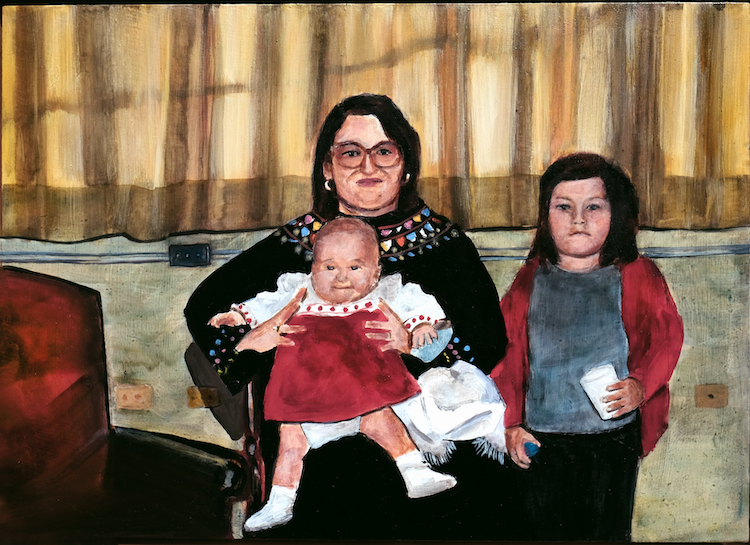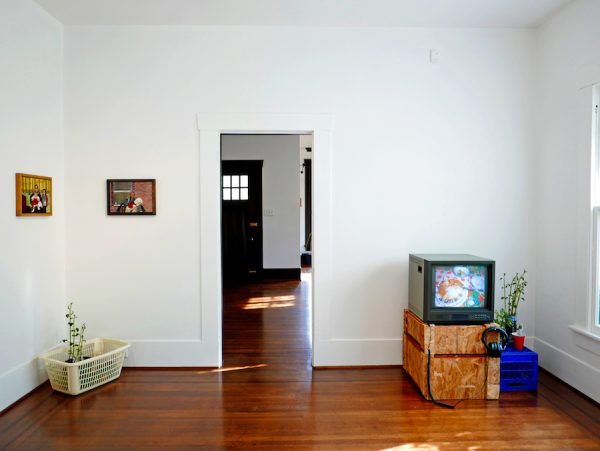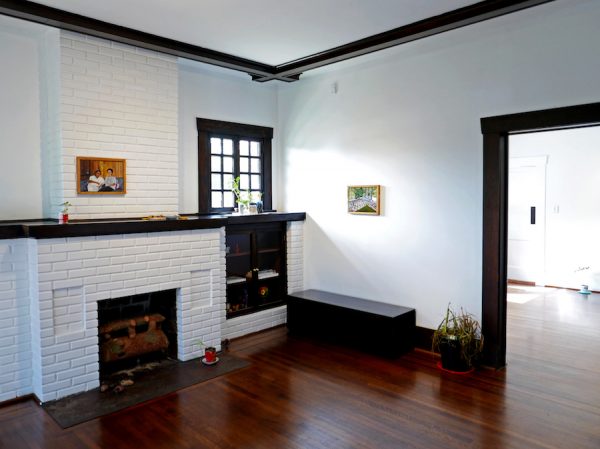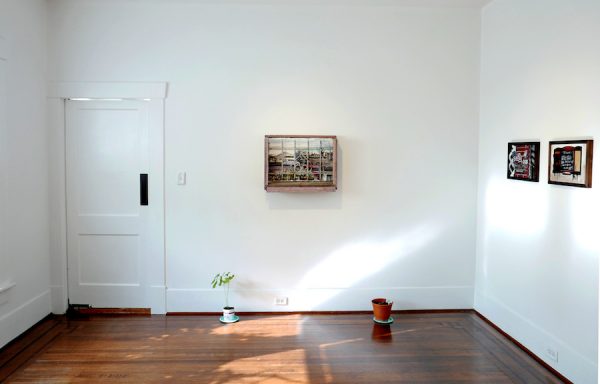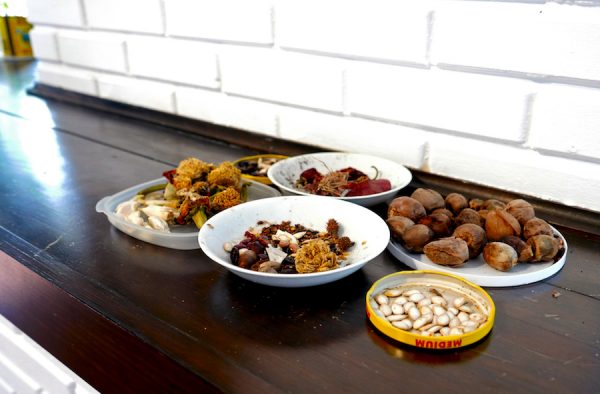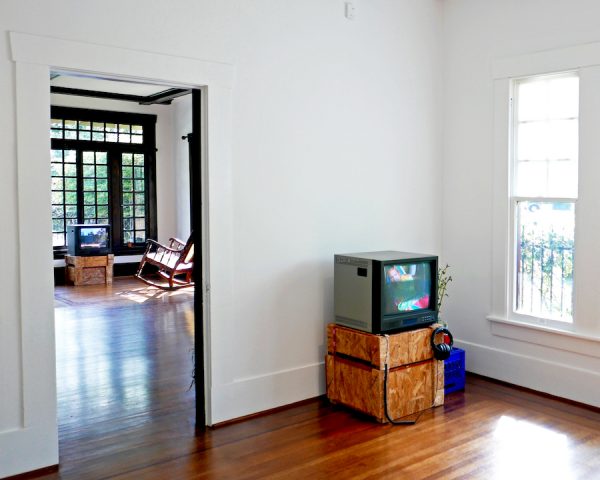This article is published concurrently with the Spring of Latino Art and the Latino Art Now! (LAN) national biennial conference and related programming taking place in Houston during the springtime of 2019.
What makes a house a home? Is it language, food, people, or decoration? Can home change, get lost, or rebuilt? These are some of the questions asked in the two-person exhibition Nuestro Hogar, which opened at Jonathan Hopson Gallery in Houston on March 10. I spoke with featured artists Francis Almendárez and Ana Fernandez, along with the exhibition’s curator Debra Barrera, about the work in the show, the work of being in the world, and the meanings of ‘home.’
Lauren Moya Ford: Debra said that our homes are our first museums, and that our first curators are the mothers and grandmothers who decorated them. I didn’t grow up going to museums, so it’s true that my biggest visual references are also emotional, because they come from my mom’s and grandmothers’ homes. What are y’all’s memories of home? Are there key objects that signal a place as home to you?
Debra Barrera: For me key objects were paintings on velvet, small porcelain figurines of animals or flowers, and parrots — both real and the papier-mâché ones with “Hecho en Mexico” written on their bellies. My father’s mother, Blanquita, kept large macaws and Mexican red-headed parrots. Their screeching echoed through abuela’s small home in Pharr, Texas as their green and red feathers rustled in their cage creating a colorful display against Blanquita’s light teal walls. These birds were my first paintings— framed portraits of something incredible but untouchable. My own home was more American and European in its sensibilities. My home only had vestiges of Mexico as my mother and father tried to assimilate into a country that shunned them harshly when they were young. However, some things remain that were more amorphous: the smell of spanish rice, cumin, and fideo cooking on the stove, Suavitel fabric softener embedded into all my clothes, countless hours of surprised and angry women in telenovelas, and the CD of Julio Iglesias on endless repeat.

Video still from Francis Almendárez’s Dinner As I Remember, 2016. Single-channel video: CRT monitor, media player, stereo sound, 03:14 TRT, installation dimensions variable.
Francis Almendárez: I come from a family of farmers on my mother’s side, so food was always around the home and at various stages of life. You could find grapes that had been set out to dry, several piles of accumulated seeds, the lard from bacon being saved to fry some beans later, or plantains so ripe that they’ve gone from black to having white spots of mold. Depending on the time of day, there were also the smells of coffee or sofrito or Vicks VapoRub and Bengay. All of these scents definitely take me back. In terms of objects, I’d say refrigerator magnets and little figurines from Central America depicting tropical fruit and sea life — those were always around, and now I seek them out whenever I go visit.
Ana Fernandez: Growing up in Corpus Christi, the Art Museum of South Texas was so influential in my primary years. It was built a few years before I was born, and my mother is a painter, so we visited often. I recall seeing lots of Latino art there: Luis Jiménez and César Martínez come to mind. I saw lots of paintings of all kinds. Because my mother exposed us to Latino art at an early age, I never felt like I didn’t belong there, because I saw myself reflected. We also spent lots of time at our respective grandmothers’ growing up. The kitchen was the center of the house. I loved watching my grandmothers cook for us.
LMF: For some immigrants and first, second, and third-generation folks, home can be a safe place to nurture the presence of another country or identity, whether through interior decoration choices, food preparation, or other private habits. Is this true for you all? Debra has said that “we (are) all inhabiting a country that is reluctant to claim us.” Is home also a place to mitigate hostility?
Debra: I think for me, my identity as a light-skinned, third/fourth generation Mexican American has allowed me to inhabit a more Texan, more “American” space, and I recognize the privileges that have come with that. However, my parents — my father born in 1935 and mother in 1940 — had perspectives on identity that were very hostile, as hostile as this country was to them. My father told me stories of being threatened as a boy and beaten up by fellow soldiers fighting in the Korean war. My mother was beaten in public school for speaking Spanish and when she was younger had to use “colored” bathrooms and water fountains. I think for all of my family, the home was a space to mitigate that hostility — to feel safe. Nuestro Hogar is in a way my sincere attempt at mitigating as well, since this gallery is also my home and I walk through the gallery spaces everyday. I have offered the artists the small artifacts I have that remind me of our shared identities to use in their installations if they wish: stone fruits, velas de Virgen De Guadalupe, and the nopales growing in my front yard. I love that this space is one that I inhabit in such a personal way. This 1914 Arts & Crafts bungalow is a magical space, and is my first real home that is not the home I grew up in.

Video still from Francis Almendárez’s Dinner As I Remember, 2016. Single-channel video: CRT monitor, media player, stereo sound, 03:14 TRT, installation dimensions variable.
Francis: Home was definitely the place where we could all just relax. Where we could wear sweats and be in our chanclas or even barefoot. My grandma was always the first to dress down, taking off her bra and putting on a loose t-shirt. And when it got hot in the summer, she would just cut the sleeves and the collar off. Home was also the place where we could speak Spanish (or Spanglish), listen to cumbias and watch reruns of Cantinflas or La India Maria. So looking back now, it makes sense why we would watch these shows, and it’s because we saw our identities reflected in those characters and felt empowered by how they mitigated racism (and misogyny) through cleverness and humor.
Ana: My Mother was born in Mexico and was naturalized when she was a small child. We spent the majority of our childhood in our maternal grandmother’s home (my Tia Sirenia & Grandma oil-on-canvas in the show portrays her) where Spanish was spoken among the adults, and English was spoken to the children. It was a true hybrid English/Spanish flow of conversation. I was lucky in that as a second-generation Mexican American, I never experienced the same blatant hostility that my parents did. I’ve experienced a more passive-aggressive style of hostility from some people here and there, particularly in rural areas or places where diversity or education levels are low. I’m just interested in creating and inhabiting my own spaces that are uniquely me. My home, my food truck, and my art. Painting is a form of making space.
LMF: Writing about Francis’ recent exhibition The Potential Wanderer in Dallas, curator Caroline Elbaor describes the immigrant experience as “an in between state of acceptance and rejection.” As someone who’s lived as a foreigner for the last four years, I really identify with that statement. But I also think it applies to people trying to be artists, and to the complex social, political, cultural dynamics of living in Texas. What do y’all think? Does alienation and acceptance figure into the work?
Debra: Definitely. I think the oscillation between alienation and acceptance is paramount in the arts, and more specifically in all of us as inhabitants of the U.S. at one point or another. I’ve been thinking a lot about American identity after a trip I took recently through the southwest. Thinking of how incredibly dense it is to be “American” and how new this country is in comparison to how long native people were on the land before the Spanish and British arrived in these continents. I think of all the various types of peoples that once inhabited and still inhabit this country — those that have come from all over the world, and those brought here against their will. The one constant of the American story, really, is that strange in-between of alienation and acceptance. In my own work I focus on this as a physical or conceptual place — the place of heterotopia that mirrors and yet upsets what is outside of it.
Francis: I’ve moved around so much my whole life that I’ve come to terms with going back and forth, and being in between those two positions. Of course, some places are warmer and more welcoming than others and that definitely helps. Nonetheless, I embrace this liminal position as it plays a large role in the work that I do, which deals with unpacking this in-betweenness, but also with situating itself between mediums.
Ana: As an artist, I’ve always felt different from most people in the first place, as a baseline, not including race, gender or sexuality. But then I wonder why other people wouldn’t like to be more like me? Rather than the other way around. I think my work embraces that view. My subjects exist as they are and how I wish to paint them.
LMF: Let’s be real: a huge part art-making and access is money. Not every artist comes from a family that can finance their education or pay their studio rent, art materials, residencies, etc. How do you balance your art practices with paying the bills? Does your job inform your artwork?
Debra: I was fortunate to have my college and graduate school paid for by both scholarships and family support. However, once out of graduate school, it was a lot harder to create work, which is why I primarily worked in graphite on paper. I’ve always had to work and juggle wearing many professional hats since graduation, and that has actually helped me create work conceptually rather than focus on only one medium. My favorite job as creative director of Jonathan Hopson is getting to curate in exactly this way for Nuestro Hogar. I feel that placing art in space is already a large part of my practice, and I am lucky for these chances to do that in a curatorial capacity with artists I truly admire.
Francis: Starting as a young boy and being the eldest, I always had to help around the home whether it was cooking, cleaning or babysitting. My parents were always working, and working multiple jobs, so their example of work ethic was always there. Labor has always been in the equation for my family and myself, and that’s why for me it’s a recurring theme in the work I create. I currently work three jobs on top of being artist. However, it’s really difficult to balance, and I have yet to figure it out. What keeps me going is that overall I enjoy what I do and I enjoy being around the people I work with and work for.
Ana: I started my own business in 2012 called “The Institute of Chili” as an art project, to bring more awareness to the Chili Queens of San Antonio. These Mexican-American entrepreneurs were said to have invented Tex-Mex food. The city banished these vendors from the downtown area once development on the Riverwalk began in the 1940s. It’s my cultural and culinary heritage and, with that in mind, I created a chili recipe that was based on the ones I found at the Institute of Texan Cultures. I’ve always worked non-traditional jobs since I was in college to try and make money so I can afford to paint.
LMF: Between the musical and vocal soundscapes, the narrative voiceovers in Francis’s installations are mesmerizing and intimate. Writing is also part of Debra’s practice. Can you all tell us more about where the texts come from, and how they figure into the process or finished pieces?
Debra: As a curator, writing is so necessary. I want to communicate effectively the reasons why I brought these artists together. I feel it also helps me understand my own work more clearly, through the lens of others’ work who I connect with.
Francis: All of my texts come from personal experiences and biography, or that of those closest to me, such as my immediate family. They started out as an experiment while experiencing culture shock during my time in London, and I’ve continued the practice since realizing how useful it is to me in thinking through and formulating my thoughts and ideas. They’re very informal initially, but as I continue to work on them they become more refined. It’s a long process, though, and it can’t be forced. I usually already have a visual or set of visuals to pair it with. So the writing happens last, and it’s my method of tying images and materials together. Though the narratives use the biographical as a point of departure, I always try and find ways to open it up to the universal and allow for the viewers to insert themselves into the narrative.
LMF: Ana’s paintings show ice-cream trucks, lotto tickets, parking lots, convenience stores — and it’s a pleasure to see such familiar sights so beautifully rendered in oil paint or fresco. In fact, in her painting Grandpa & Zoomer, the man looks just like my uncle! But not every viewer will be able to connect to the work so viscerally. Does the reception of y’all’s work change depending on the audience? How do we draw viewers into a world that they haven’t experienced?
Debra: One time I was reading correspondence between Frank O’Hara and Willem de Kooning where O’Hara basically writes that the more personal the work is the more available it is to others. Ever since I’ve seen my practice differently. My work used to be less personal, and for the past few years I’ve really allowed myself to be vulnerable in my practice. I think both Ana and Francis have totally opened new doors with this exhibit, and that magic of working more personally to be more available is really happening here. When I look at what they have created for this show I see incredible strength, power, and genuineness. These two artists are — first and foremost — great artists. The personal subject matter is inextricably linked to their work but it is not why the work is good. I believe that when an artist is able to be vulnerable and honest in their practice, that connection gets imbued and radiates outward to any viewer. Some visitors may not have a cultural link to the work as someone from a similar background might, but that does not take away the power of the work. For those visitors who do have a cultural link to this exhibit, I hope it can help them feel more comfortable in the art-world landscape and see they too have a very valid and important space to inhabit here. Nuestro Hogar is a portrait of human experience that in its intimate and visual power connects to others on a simple truth: we all need to call somewhere our home.
Francis: Different audiences will of course receive the work differently, however, I don’t think people need to necessarily have the same or similar experiences to be drawn into a work. I think if there’s a sense of honesty on the part of the artist, that’s oftentimes enough to grab someone’s attention. In these texts that I voiceover, I don’t think they’d have the same effect if it was an actor reading them aloud. As much as I dislike the sound of my own voice, it’s my voice that gives depth and nuance to the text, as only I know its inflection.
Ana: I love that my grandpa looks like your uncle! I think some people might connect on a deeper level because of familiarity with the places or people I paint. But for me, painting is a form communication that can transcend boundaries. It’s our humanity that bonds as all together in the end.
On view at Jonathan Hopson Gallery in Houston through April 28, 2019
Lauren Moya Ford is an artist and writer based in Madrid.


